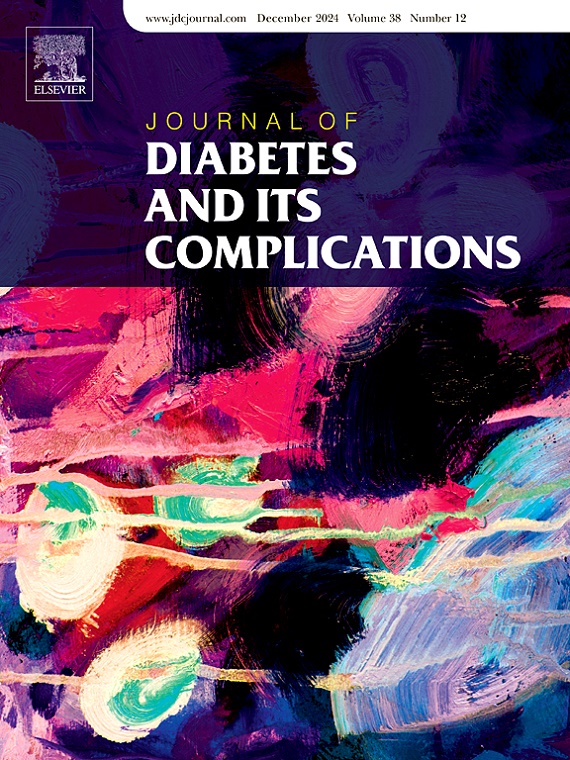自身免疫性结节病中糖尿病的患病率和临床影响:系统综述。
IF 2.9
3区 医学
Q3 ENDOCRINOLOGY & METABOLISM
引用次数: 0
摘要
背景和目的:自身免疫性结节病是一种新近确立的免疫介导的周围神经病亚型,其特征是针对结节-副结节蛋白的循环自身抗体,这些蛋白包括接触素-1(CNTN1)、接触素相关蛋白-1(Caspr1)、神经筋膜蛋白-155(NF155)和神经筋膜蛋白异构体(NF140和NF186)。新的证据表明,糖尿病(DM)可能会增加自身免疫性结节病的风险:我们进行了一项系统性检索,包括对携带结节/副结节抗体(CNTN1、Caspr1、NF155、NF140 和 NF186)患者的研究报告。我们试图评估:(1) DM 在自身免疫性结节病患者中的发病率;(2) 携带不同类型结节/副结节抗体的 DM 患者的表型;(3) 可将自身免疫性结节病与糖尿病周围神经病变 (DPN) 区分开来的临床特征:结果:共发现 5 项队列研究、3 项病例报告和 1 项病例系列研究,包括 114 名自身免疫性结节病患者。据记录,糖尿病的发病率在 10.5% 到 60% 之间。DM患者主要携带副结节抗体;CNTN1抗体:58.3%,其次是泛神经鞘磷脂抗体:33.3%,Caspr1抗体:25%。DM患者与非DM患者的临床表型无明显差异。总体而言,DM患者对静脉注射免疫球蛋白(IVIG)难治,但对升级免疫疗法反应良好。与DPN相比,自身免疫性结节病的显著特点包括:(i) 严重共济失调、震颤和颅神经受累;(ii) 神经电生理结果表明结节-副结节病变,包括(可逆的)传导衰竭和传导速度减慢,通常伴有复合肌肉和感觉神经动作电位降低;(iii) 脑脊液分析中明显的蛋白升高或白蛋白细胞学分离:结论:DM 患者属于典型的自身免疫性结节病临床表型,主要表现为结节旁抗体。早期怀疑至关重要,因为与 DPN 不同,自身免疫性结节病的诊断为治疗提供了前景。本文章由计算机程序翻译,如有差异,请以英文原文为准。
Prevalence and clinical implications of diabetes mellitus in autoimmune nodopathies: A systematic review
Background and aims
Autoimmune nodopathies comprise a newly-established subtype of immune-mediated peripheral neuropathies, characterized by circulating autoantibodies that target nodal-paranodal proteins, including contactin-1 (CNTN1), contactin-associated protein-1 (Caspr1), neurofascin-155 (NF155) and neurofascin-isoforms (NF140 and NF186). Emerging evidence suggests that diabetes mellitus (DM) may confer increased risk for autoimmune nodopathies.
Methods
A systematic search was performed including studies reporting on patients harboring nodal/paranodal antibodies (CNTN1, Caspr1, NF155, NF140 and NF186). We sought to evaluate: (1) the prevalence of DM among patients with autoimmune nodopathies; (2) the phenotype of DM-patients harboring different types of nodal/paranodal antibodies; (3) clinical features that allow distinction of autoimmune nodopathies from diabetic peripheral neuropathy (DPN).
Results
Five cohort studies, 3 case-reports and one case-series study were identified comprising 114 patients with autoimmune nodopathies. DM prevalence was documented to range between 10.5 % and 60 %. DM-patients harbored mostly paranodal antibodies; CNTN1: 58.3 %, followed by pan-neurofascin: 33.3 %, and Caspr1: 25 % antibodies. No significant differences in clinical phenotype were uncovered between DM-patients and their non-DM counterparts. Overall, DM patients were refractory to intravenous-immunoglobulins (IVIG), but responded well to escalation immunotherapies. Compared to DPN, distinctive features of autoimmune nodopathy comprised: (i) severe ataxia, tremor, and cranial nerve involvement; (ii) neurophysiological findings indicative of nodal-paranodal pathology, including (reversible) conduction failure and conduction velocity slowing, often accompanied by reduced compound muscle and sensory nerve action potentials; and (iii) marked protein-elevation or albuminocytological dissociation in cerebrospinal fluid analysis.
Conclusions
DM patients fall under the typical clinical phenotype of autoimmune nodopathy, displaying predominantly paranodal antibodies. Early suspicion is crucial, as unlike DPN, diagnosis of autoimmune nodopathy unfolds therapeutic perspectives.
求助全文
通过发布文献求助,成功后即可免费获取论文全文。
去求助
来源期刊

Journal of diabetes and its complications
医学-内分泌学与代谢
CiteScore
5.90
自引率
3.30%
发文量
153
审稿时长
16 days
期刊介绍:
Journal of Diabetes and Its Complications (JDC) is a journal for health care practitioners and researchers, that publishes original research about the pathogenesis, diagnosis and management of diabetes mellitus and its complications. JDC also publishes articles on physiological and molecular aspects of glucose homeostasis.
The primary purpose of JDC is to act as a source of information usable by diabetes practitioners and researchers to increase their knowledge about mechanisms of diabetes and complications development, and promote better management of people with diabetes who are at risk for those complications.
Manuscripts submitted to JDC can report any aspect of basic, translational or clinical research as well as epidemiology. Topics can range broadly from early prediabetes to late-stage complicated diabetes. Topics relevant to basic/translational reports include pancreatic islet dysfunction and insulin resistance, altered adipose tissue function in diabetes, altered neuronal control of glucose homeostasis and mechanisms of drug action. Topics relevant to diabetic complications include diabetic retinopathy, neuropathy and nephropathy; peripheral vascular disease and coronary heart disease; gastrointestinal disorders, renal failure and impotence; and hypertension and hyperlipidemia.
 求助内容:
求助内容: 应助结果提醒方式:
应助结果提醒方式:


